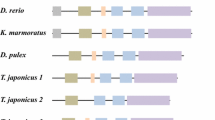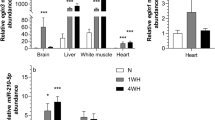Abstract
Oxygen deprivation is a lethal stress that only a few animals can tolerate for extended periods. This study focuses on analyzing the role of DNA methylation in aiding natural anoxia tolerance in a champion vertebrate anaerobe, the red-eared slider turtle (Trachemys scripta elegans). We examined the relative expression and total enzymatic activity of four DNA methyltransferases (DNMT1, DNMT2, DNMT3a and DNMT3b), two methyl-binding domain proteins (MBD1 and MBD2), and relative genomic levels of 5-methylcytosine under control, 5 h anoxic, and 20 h anoxic conditions in liver, heart, and white skeletal muscle (n = 4, p < 0.05). In liver, protein expression of DNMT1, DNMT2, MBD1, and MBD2 rose significantly by two- to fourfold after 5 h anoxic submergence compared to normoxic-control conditions. In heart, 5 h anoxia submergence resulted in a 1.4-fold increase in DNMT3a levels and a significant decrease in MBD1 and MBD2 levels to ~30 % of control values. In white muscle, DNMT3a and DNMT3b increased threefold and MBD1 levels increased by 50 % in response to 5 h anoxia. Total DNMT activity rose by 0.6–2.0-fold in liver and white muscle and likewise global 5mC levels significantly increased in liver and white muscle under 5 and 20 h anoxia. The results demonstrate an overall increase in DNA methylation, DNMT protein expression and enzymatic activity in response to 5 and 20 h anoxia in liver and white muscle indicating a potential downregulation of gene expression via this epigenetic mechanism during oxygen deprivation.





Similar content being viewed by others
References
Alexandrov A, Chernyakov I, Gu W, Hiley SL, Hughes TR, Grayhack EJ, Phizicky EM (2006) Rapid tRNA decay can result from lack of nonessential modifications. Mol Cell 21:87–96
Avvakumov GV, Walker JR, Xue S, Li Y, Duan S, Bronner C, Arrowsmith CH, Dhe-Paganon S (2008) Structural basis for recognition of hemi-methylated DNA by the SRA domain of human UHRF1. Nature 455:822–825
Barlow DP (1993) Methylation and imprinting: from host defense to gene regulation? Science 260:309–310
Beall R, Privitera C (1973) Effects of cold exposure on cardiac metabolism of the turtle Chrysemys picta. Am J Physiol 224:435–441
Bestor TH, Tycko B (1996) Creation of genomic methylation patterns. Nat Genet 12:363–367
Biggar KK, Storey KB (2012) Evidence of cell cycle suppression and microRNA regulation of cyclin D1 during anoxia exposure in turtles. Cell Cycle 9:1705–1713
Biggar KK, Groom AG, Storey KB (2011) Hypometabolism and turtles: physiological and molecular strategies of anoxic survival. In: Nowakowska A, Caputa M (eds) Hypometabolism: strategies of survival in vertebrates and invertebrates. Research Signpost, Kerala, pp 57–94
Bird A (2002) DNA methylation patterns and epigenetic memory. Genes Dev 16(6):21
Bird AP, Wolffe AP (1999) Methylation-induced repression belts, braces, and chromatin. Cell 99:451–454
Bogdanovic O, Veenstra JC (2009) DNA methylation and methyl-CpG binding proteins: developmental requirements and function. Chromosoma 118:549–565
Boutilier R, Donohoe P, Tattersall G, West T (1997) Hypometabolic homeostasis in overwintering aquatic amphibians. J Exp Biol 200:387–400
Boyes J, Bird A (1991) DNA methylation inhibits transcription indirectly via a methyl-CpG binding protein. Cell 64:1123–1134
Buck LT, Land SC, Hochachka PW (1993) Anoxia-tolerant hepatocytes: model system for study of reversible metabolic suppression. Am J Physiol 265:49–56
Calvanese V, Lara E, Kahn A, Fraga MF (2009) The role of epigenetics in aging and age-related diseases. Ageing Res Rev 8:268–276
Chiacchiera F, Piunti A, Pasini D (2013) Epigenetic methylations and their connections with metabolism. Cell Mol Life Sci 70:1495–1508
Fraser K, Houlihan D, Lutz DP, Leone-Kabler S, Manuel L, Brechin J (2001) Complete suppression of protein synthesis during anoxia with no post-anoxia protein synthesis debt in the red-eared slider turtle Trachemys scripta elegans. J Exp Biol 204:4353–4360
Goll MG, Bestor TG (2005) Eukaryotic cytosine methyltransferases. Annu Rev Biochem 74:481–514
Goll MG, Kirpekar F, Maggert KA, Yoder JA, Hsieh CL, Zhang X, Golic KG, Jacobsen SE, Bestor TH (2006) Methylation of tRNAAsp by the DNA methyltransferase homolog Dnmt2. Science 311:395–398
Grewal SIS, Moazed D (2003) Heterochromatin and epigenetic control of gene expression. Science 301:798–802
Herbert CV, Jackson DC (1985) Temperature effects on the responses to prolonged submergence in the turtle Chrysemys picta bellii. II. Metabolic rate, blood acid-base and ionic changes, and cardiovascular function in aerated and anoxic water. Physiol Zool 58:670–681
Hermes-Lima M, Zenteno-Savin T (2002) Animal response to drastic changes in oxygen availability and physiological oxidative stress. Comp Biochem Physiol C: Toxicol Pharmacol 133:537–556
Hochachka PW, Buck LT, Doll CJ, Land SC (1996) Unifying theory of hypoxia tolerance: molecular/metabolic defense and rescue mechanisms for surviving oxygen lack. Proc Natl Acad Sci USA 93:9493–9498
Jackson DC (2002) Hibernating without oxygen: physiological adaptations of the painted turtle. J Physiol 543:731–737
Jackson DC, Heisler N (1982) Plasma ion balance of submerged anoxic turtles at 3 °C: the role of calcium lactate formation. Respir Physiol 49:159–174
Jackson DC, Crocker CE, Ultsch GR (2000) Bone and shell contribution to lactic acid buffering of submerged turtles Chrysemys picta bellii at 3 °C. Am J Physiol Regul Integr Comp Physiol 278:1564–1571
Jeltsch A, Nellen W, Lyko F (2006) Two substrates are better than one: dual specificities for DNMT2 methyltransferases. Trends Biochem Sci 31:306–308
Jones PL, Veenstra GJ, Wade PA, Vermaak D, Kass SU, Landsberger N, Strouboulis J, Wolffe AP (1998) Methylated DNA and MeCP2 recruit histone deacetylas to repress transcription. Nat Ganet 19:187–191
Klose RJ, Bird AP (2006) Genomic DNA methylation: the mark and its mediators. Trends Biochem Sci 31:89–97
Krivoruchko A, Storey KB (2010a) Epigenetics in anoxia tolerance: a role for histone deacetylases. Mol Cell Biochem 342:151–161
Krivoruchko A, Storey KB (2010b) Molecular mechanisms of turtle anoxia tolerance: a role for NF-kappaB. Gene 450:63–69
Krivoruchko A, Storey KB (2013) Anoxia-responsive regulation of the FoxO transcription factors in freshwater turtles, Trachemys scripta elegans. Biochim Biophys Acta 1830:4990–4998
Krivoruchko A, Storey KB (2014) Activation of the carbohydrate response element binding protein (ChREBP) in response to anoxia in the turtle (Trachemys scripta elegans). Biochim Biophys Acta 1840:3000–3005
Lutz PL, Milton SL (2004) Negotiating brain anoxia survival in the turtle. J Exp Biol 207:3141–3147
Lutz PL, Storey KB (1997) Adaptations to variations in oxygen tension by vertebrates and invertebrates. In: Dantzler WH (ed) Handbook of physiology, section 13, Comparative physiology, vol 2. Oxford University Press, Oxford, pp 1479–1522
Macaluso M, Montanari M, Cinti C, Giordano A (2005) Modulation of cell cycle components by epigenetic and genetic events. Semin Oncol 32:452–457
Ng HH, Zhang Y, Hendrich B, Johnson CA, Turner BM, Erdjument-Bromage H, Tempest P, Reignberg D, Bird A (1999) MBD2 is a transcriptional repressor belonging to the MeCP1 histone deacetylase complex. Nat Genet 1:58–61
Okano M, Xie S, Li E (1998) Cloning and characterization of a family of novel mammalian DNA (cytosine-5) methyltransferases. Nat Genet 19:219–220
Okano M, Bell DW, Haber DA, Li E (1999) DNA methyltransferases Dnmt3a and Dnmt3b are essential for de novo methylation and mammalian development. Cell 99:247–257
Ramsahoye BH, Biniszkiewics D, Lyko F, Clark V, Bird AP, Jaenisch R (2000) Non-CpG methylation is prevalent in embryonic stem cells and may be mediated by DNA methyltransferase 3a. Proc Natl Acad Sci USA 97:5237–5242
Rolfe DF, Brown GC (1997) Cellular energy utilization and molecular origin of standard metabolic rate in mammals. Physiol Rev 77:731–758
Schaefer M, Pollex T, Hanna K, Tuorto F, Meusburger M, Helm M, Lyko F (2010) RNA methylation by Dnmt2 protects transfer RNAs against stress-induced cleavage. Genes Dev 24:1590–1595
Sharif J, Muto M, Takebayashi S, Suetake I, Iwamatsu A, Endo TA, Shinga J, Mizutani-Koseki Y, Toyoda T, Okamura K, Tajima S, Mitsuya K, Okano M, Koseki H (2007) The SRA protein Np95 mediates epigenetic inheritance by recruiting DNMT1 to methylated DNA. Nature 7171:908–912
Storey KB (1975) Purification and properties of turtle heart creatine kinase: role for the enzyme in glycolytic control. Int J Biochem 6:53–59
Storey KB (2007) Anoxia tolerance in turtles: metabolic regulation and gene expression. Comp Biochem Physiol A 147:263–276
Storey KB, Storey JM (1990) Metabolic rate depression and biochemical adaptation in anaerobiosis, hibernation and estivation. Q Rev Biol 65:145–174
Storey KB, Storey JM (2007) Tribute to P.L. Lutz: putting life on ‘pause’—molecular regulation of hypometabolism. J Exp Biol 210:1700–1714
Ultsch GR (1985) The viability of nearctic freshwater turtles submerged in anoxia and normoxia at 3 and 10 °C. Comp Biochem Physiol A 3:607–611
Ultsch GR (2006) The ecology of overwintering among turtles: where turtles overwinter and its consequences. Biol Rev 81:339–367
Ultsch GR, Jackson DC (1982) Long-term submergence at 3 °C of the turtle, Chrysemys picta bellii, in normoxic and severely hypoxic water: survival, gas exchange and acid-base status. J Exp Biol 96:11–28
Van der Maarel SM (2008) Epigenetic mechanisms in health and disease. Ann Rheum Dis 67:97–100
Waddington CH (1942) Canalization of development and the inheritance of acquired characters. Nature 150:563–565
Watt F, Molloy PL (1998) Cytosine methylation prevents binding to DNA of HeLa cell transcription factor required for optimal expression of the adenovirus major late promoter. Genes Dev 2:1136–1143
Wolffe AP, Matzke MA (1999) Epigenetics: regulation through repression. Science 286:481–486
Acknowledgements
Thanks to J.M. Storey for editorial review of the manuscript. This work was supported by a Discovery grant from the Natural Sciences and Engineering Research Council (NSERC) of Canada (Grant #: 6793). KBS holds the Canada Research Chair in Molecular Physiology and SW holds a postgraduate Queen Elizabeth II Graduate Scholarship in Science and Technology.
Author information
Authors and Affiliations
Corresponding author
Additional information
Communicated by G. Heldmaier.
Rights and permissions
About this article
Cite this article
Wijenayake, S., Storey, K.B. The role of DNA methylation during anoxia tolerance in a freshwater turtle (Trachemys scripta elegans). J Comp Physiol B 186, 333–342 (2016). https://doi.org/10.1007/s00360-016-0960-x
Received:
Revised:
Accepted:
Published:
Issue Date:
DOI: https://doi.org/10.1007/s00360-016-0960-x




